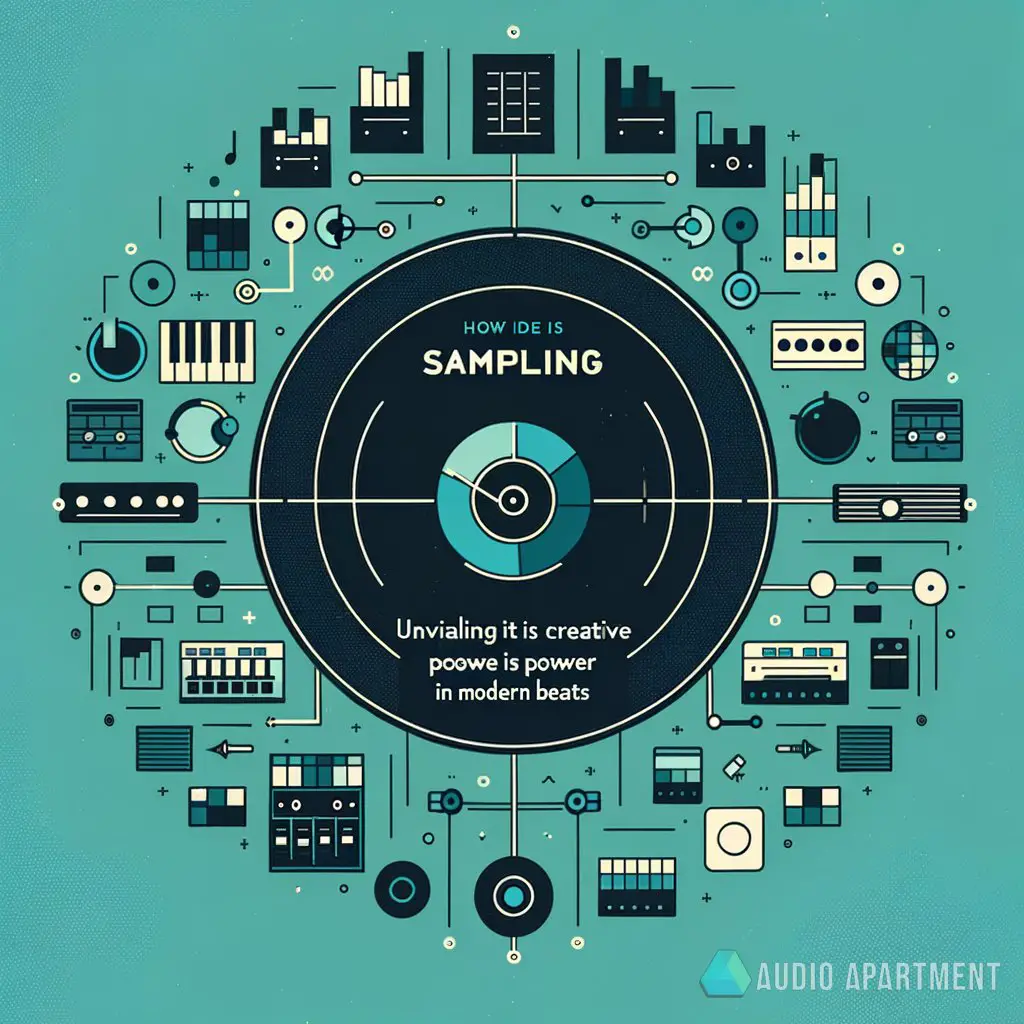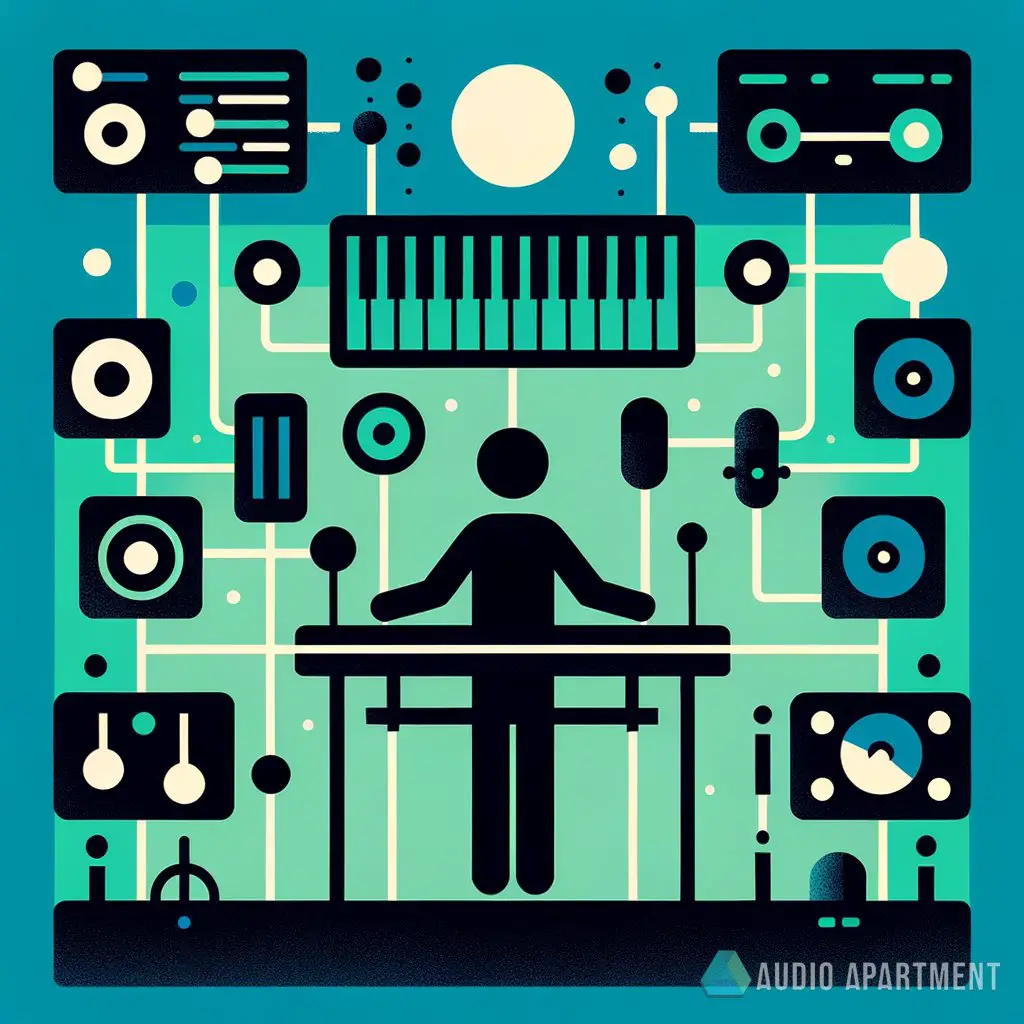Hey, ever notice how sampling in music production can turn a familiar tune into a fresh masterpiece or start a fiery debate about originality? Just like how finding the right studio monitors could spark heated discussions in audiophile groups.
Why does sampling stir up the mix? We’ll explore its ins and outs, plus the nuances every budding producer needs to know.
If you are a visual learner, check out this video titled ‘What is Sampling? | Music Production | Loudon Stearns | Beginner | Berklee Online’
Key takeaways
- Sampling can create hooks that transform and redefine a track.
- Beats gain a heartbeat through the strategic use of sampled rhythms.
- Sampling adds textural dreamscapes that enhance the listener’s experience.
- Mashups and remixes offer reinterpretations that bridge diverse musical worlds.
What are the dynamic uses of sampling in today’s music scene?
Sampling isn’t just a tool; it’s an art form that weaves the old with the new, creating layers of sound that tell a story. It’s like finding the secret ingredient that turns a good track into a bop.

In this list, we’ll dish out the variety of ways producers flip a sample, from the backbone of a beat to unexpected texture.
1. Creating the hook
Producers usually dig through crates of vintage records to unearth a catchy portion of a song to formulate the centerpiece of their new track. This snippet, or sample, becomes the hook – a memorable melody or rhythm that can transform the vibe of a track.
Such hooks can either pay homage or give a total makeover to the original piece. It’s like the DJ’s form of quoting a classic, turning past grooves into today’s hits.
For that crystal-clear replay, you might want to check out the best studio headphones to catch all the nuances.
Sampling for hooks also allows producers to tap into nostalgia, giving listeners a blast from the past while introducing them to new jams. It’s about mixing that old-school flavor with contemporary beats, making it a chill yet thicc layer in the mix.
The result? A track that slaps with layers of depth, showing how the past can ignite the future.
2. Beat making foundation
The beat is the heart of any hip-hop or electronic track, and samples can serve as its pulse. Producers cut a funky drum break or a soulful bassline from an existing record to lay down the groove foundation.

By doing so, they salute the legends while also reinventing the rhythm for their own narrative. It’s akin to finding the right vocal production technique that makes the track shine.
Sampling lays down a solid groundwork that producers can build upon, adding other elements like synths or vocal chops to create a full, rich sound. This type of sampling keeps the vibe of the original piece alive but gives it fresh breath, reviving dusty beats into vibrant bangers.
It’s a tasteful nod to the architects of rhythm, stitched seamlessly into the fabric of new school hits.
3. Textural layers
Beyond the obvious beats and hooks, sampling can add subtle textures to music. Snippets of ambient sounds, vinyl crackle, or even dialogue from old movies can create an atmosphere that’s chill AF.
These layers might not always be front and center, but they add a unique depth and feeling to a production, echoing the importance of adding spatial depth with reverb in a mix.
This use of sampling as texture invites listeners to a multi-sensory experience, crafting a soundscape that can transport them to different moments in time or places in the mind. It fuses the familiar with the experimental, painting a sonic picture that’s as rich in vibe as it is in history, giving an ambient nod to the echoes of yesteryears.

4. Live performance elements
In live performances, DJs and producers usually wield samples like sonic weapons, dropping bombs that get the crowd lit. They repurpose sounds from across the musical spectrum to amplify energy, craft transitions, and highlight drops.
Whether it’s triggering an 808 bass to rattle the rafters or a vintage horn section to raise the roof, samples become pivotal live performance tools. You’ll want the right MIDI controllers to trigger those samples with precision.
Moreover, samples in live sets allow artists to flex their musical knowledge and show their chops in real-time. It’s an interactive element that bridges the gap between the studio and the stage, turning isolated sounds from past records into communal bangers.
It’s all about that shared vibe, creating a live moment that’s hella immersive and super dynamic.
5. Mashups and remixes
Sampling takes the front seat when DJs combine multiple tracks to fabricate a mashup or remix. It’s taking the original work’s essence and repackaging it with a fresh twist that respects the original while sailing in a new direction.
“Sampling is a game of balance and creativity, requiring you to mix historical awareness with visionary audio alchemy. It’s about mixing the right ingredients to create a sonic blend that slaps.”
Think of it like mixing the perfect cocktail: blending distinct flavors to deliver a sip that snaps with innovation and familiarity – which reminds me, peep the essentials of achieving a balanced stereo image in mixing.
These reimagined concoctions can bring disparate genres together or simply refresh a classic hit in a way that captures today’s vibe. From viral dance floors to chill study beats, mashups and remixes showcase the transformative and unifying power of sampling in the ever-evolving music landscape.
AKAI Professional MPK Mini MK3

AKAI Professional MPK Mini MK3
More sampling tips
Sampling is a game of balance and creativity, requiring you to mix historical awareness with visionary audio alchemy. Like a bartender crafting the perfect cocktail with a twist, sampling is about mixing the right ingredients to create a sonic blend that slaps.
- Dig deep into diverse music genres to find unique samples that can set your track apart
- Play with pitch and tempo to fit the sample into your track’s vibe
- Layer different samples to create complex textures
- Use high-quality audio files to maintain clarity in your mix
- Take advantage of sampling to recontextualize a sound and give it a new meaning
- Keep it legal by clearing samples if necessary to avoid any future mix-ups
Before diving into the world of sampling, there are some best practices to keep your workflow smooth and your productions legal. Here’s a chill guide on what to do and what to avoid.
| Do | Don’t |
|---|---|
| Clear the rights to samples to avoid copyright issues. | Use uncleared samples that could land you in legal hot water. |
| Use samples to enhance your track, not carry it. | Rely solely on samples, which can stifle your creativity. |
| Edit and modify samples to fit your track’s context. | Use a sample without any modification, making it less original. |
| Credit the original artist if the sample is recognizable. | Forget to give props to the original creators when due. |
| Keep backups of your project files and samples. | Lose your work by not backing up your sessions and sounds. |
| Experiment with lesser-known sources for a unique sound. | Stick to the same overused samples everyone else is using. |
The careful balance of sampling artistry and respect for original creation.
Advantages and disadvantages of sampling
Sampling is a cornerstone of modern music production, offering a bridge between eras and styles. It’s a method celebrated for its innovation but also scrutinized over originality and copyright issues.
Let’s break down the pros and cons of adding samples into music.
Advantages
- Injects familiarity and nostalgia into a new track, potentially broadening its appeal
- Saves time in the music creation process by using pre-recorded elements
- Provides an opportunity to pay homage to musical influences and classics
- Offers endless creative possibilities by manipulating and layering sounds
- Can enhance a track’s texture and depth with minimal effort
Disadvantages
- Potential legal complications if samples are not cleared
- Over-reliance on samples may limit development of originality
- Risk of homogeneity with widespread use of popular samples
- May overshadow other elements within a track if not balanced well
- Ethical concerns about the appropriation of other artists’ work without due credit
In my humble opinion, as someone who’s always been fascinated by the way old tunes can be reborn in modern tracks, sampling feels like a bridge connecting different musical epochs. It’s not just about lifting a hook; it’s about creating something new, something that carries the spirit of the original but fits snugly into today’s vibe.
For instance, finding the perfect union between a smoky jazz sax and a crisp trap beat—that’s like hitting a jackpot in the audio blend casino. Plus, checking out discussions on the role of digital signal processors in audio production could enrich your sample manipulation skills.
On a personal note, though, I’ve got to admit that there’s a tiny voice in the back of my mind whispering about the importance of originality. As much as I’m stoked about the dope soundscapes sampling can create, I also get why some heads might side-eye a track that leans too heavy on past creations.
It’s like, yeah, repurpose that vintage flavor, but don’t let it outshine your own artistic essence. You gotta keep it balanced, like a good mix—let your sampling serve the track, not dominate it.
Frequently asked questions (FAQ)
How do you ensure samples fit the tempo and key of your track?
Choosing the right sample is just the beginning—you need to make sure it meshes with your track’s tempo and key. Modern DAWs come packed with tools that can stretch and pitch-shift samples to fit your project like a glove.
It’s like tailoring a vintage suit; sometimes it requires a nip here or a tuck there, but done right, it’ll look and sound fly as hell.
Can you sample anything, or are there restrictions?
Sampling is a playground with fences. You can swing from the sounds of nature to vintage vinyl, but you gotta respect copyright laws.
If you’re thinking of snagging that hot guitar riff from a classic rock anthem, be aware: you may need to clear it first to avoid legal mix-ups. Be a savvy sampler—not a courtroom regular.
What’s the future of sampling in music production?
With music tech evolving faster than a breakbeat at a drum ‘n’ bass gig, the future of sampling is looking lit. Artists and producers are pushing boundaries, using AI and machine learning to discover and manipulate samples in ways that are hella fresh and innovative.
Cutting-edge software is making it easier to create, tweak, and flip samples, so who knows? Tomorrow’s hit could be a hyper-sampled sonic collage that’s all vibe.
Final thoughts
As we slide the fader down on this discussion, it’s clear that sampling remains a keystone in the arch of modern music production. It transcends genres, connects eras, and fuels creativity.
Whether you’re just starting your journey or you’ve been on this beat for a minute, remember that sampling offers a world of opportunity—if you can hit the right balance, your tracks will not just sound good, they’ll feel good. Keep on exploring, keep on creating, and most importantly, keep that music playing.
How has sampling influenced your favorite tracks? Did I cover everything you wanted to know? Let me know in the comments section belowI read and reply to every comment. If you found this article helpful, share it with a friend, and check out my full blog for more tips and tricks on sampling.
Thanks for reading and keep riding that sound wave.















